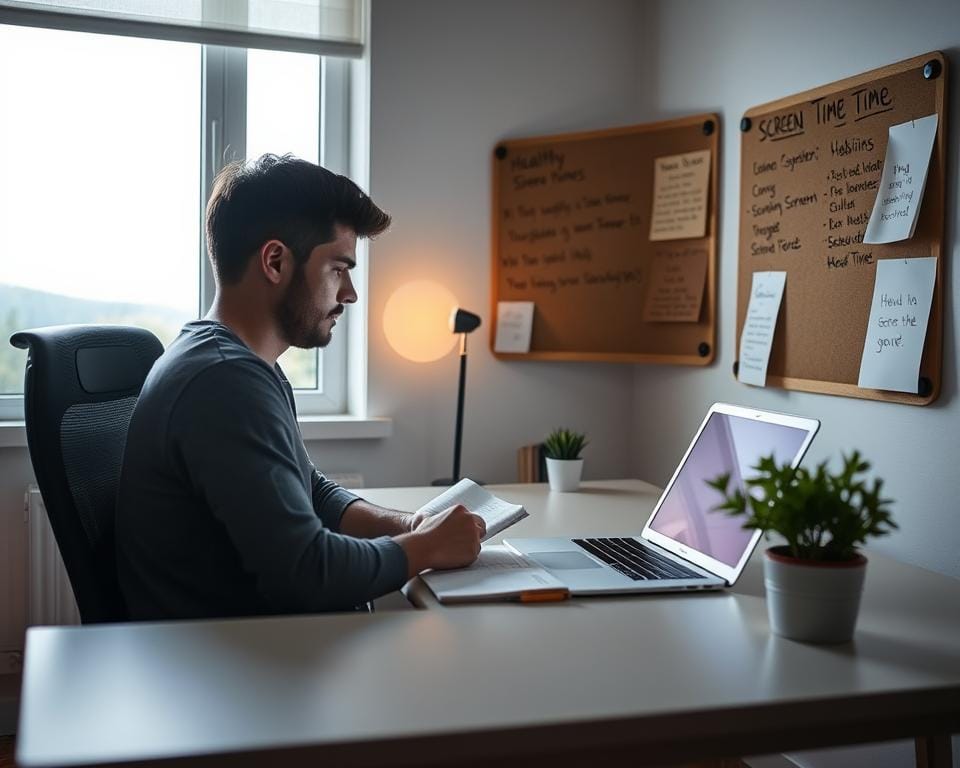Table of Contents
In today’s digital age, screens have become an inseparable part of our daily lives. From smartphones to laptops, we rely on these devices for work, entertainment, and staying connected. But have you ever felt drained after hours of scrolling through social media or binge-watching videos? You’re not alone.

Research shows that prolonged screen time can disrupt our sleep, strain our eyes, and even affect our mental health. Blue light emitted by devices interferes with melatonin production, making it harder to fall asleep1. Additionally, excessive screen use has been linked to higher rates of anxiety and depression2.
Dr. Justin Kei emphasizes the need for intentional screen usage to improve overall well-being. By setting boundaries and creating device-free zones, we can reclaim our time and focus on what truly matters. Small changes, like limiting social media or spending more hours with family, can make a big difference.
Let’s explore how managing our screen habits can lead to a healthier, more balanced life. Together, we can find ways to stay connected without letting screens take over.
Understanding the Impact of Excessive Screen Exposure
The digital world surrounds us, shaping how we live, work, and connect. While devices offer convenience, overuse can take a toll on our mental and physical well-being. Research shows that prolonged screen time can lead to anxiety, depression, and sleep disturbances3.
Mental Health and Emotional Well-Being
Spending too much time on social media or other digital platforms can affect our mood. Studies link excessive use to higher rates of anxiety and depression4. The constant comparison and information overload can lower self-esteem and create stress.
Teens, in particular, face challenges. They spend an average of eight hours a day on devices, which is two hours more than in 20153. This habit can disrupt their emotional balance and lead to behavioral issues.
Physical Effects and Posture Considerations
Extended use of devices isn’t just a mental health concern. It can also harm our bodies. Poor posture from slouching over a phone or laptop often leads to back pain and discomfort5.
Eye strain is another common problem. The 20-20-20 rule—looking at something 20 feet away for 20 seconds every 20 minutes—can help reduce this issue5. Taking breaks to stretch and move is equally important.
For more insights on how excessive screen exposure affects health, visit this resource.
Practical Strategies for Cutting Down Screen Time
Taking control of how we use technology can lead to a healthier lifestyle. Many of us spend hours on our devices, but small changes can make a big difference. Let’s explore actionable steps to manage our digital habits effectively.
Establishing Digital Boundaries and Routines
Setting clear boundaries is the first step. Start by scheduling specific times for device use. For example, limit social media to 30 minutes a day. This helps regain focus and reduces distractions6.
Another strategy is to create a daily routine. Allocate time for work, family, and hobbies. Avoid using your phone during meals or an hour before bed. This improves sleep quality and strengthens family bonds7.
Creating Device-Free Zones and Monitoring Usage
Designate areas in your home where devices are not allowed. The dining room and bedroom are great places to start. This encourages face-to-face interactions and reduces dependency on screens6.
Use built-in tools to track your usage. Many smartphones have features that show how much time you spend on apps. Set daily limits and stick to them. This helps you stay in control of your digital life7.
Here’s a quick guide to help you get started:
| Strategy | Action | Benefit |
|---|---|---|
| Set Boundaries | Limit social media to 30 minutes/day | Improved focus |
| Create Routine | No phone during meals | Better family time |
| Device-Free Zones | No devices in bedrooms | Enhanced sleep |
| Monitor Usage | Use app tracking features | Greater control |
By implementing these strategies, we can create a healthier balance between technology and daily life. Start small, stay consistent, and enjoy the positive changes.
Benefits of Reducing Screen Time
Small adjustments in our digital habits can lead to big improvements. By limiting our use of devices, we can unlock a range of positive changes in our lives. Let’s explore how these shifts can enhance our well-being.

Better Sleep, Sharper Focus, and Less Stress
One of the most immediate effects of cutting back on screen time is improved sleep. Research shows that exposure to blue light from devices disrupts our circadian rhythms, making it harder to fall asleep8. By avoiding screens an hour before bed, we can improve sleep quality and wake up feeling refreshed9.
Less time on devices also boosts focus and productivity. Studies indicate that reducing distractions can increase productivity by up to 25%9. This allows us to accomplish more in less time, leaving room for other activities.
Additionally, limiting social media use can lower stress levels. Surveys show that 30% of users feel overwhelmed by their interactions online9. Stepping away from these platforms can create a calmer, more balanced mental state.
Stronger Family Bonds and More Movement
When we spend less time on screens, we open up opportunities for meaningful interactions. Designating device-free zones, like the dining room, encourages face-to-face conversations10. This strengthens family bonds and creates lasting memories.
Reducing screen time also promotes physical activity. Instead of sitting for hours, we can engage in hobbies, exercise, or outdoor adventures. This not only improves physical health but also reduces the risk of obesity and related conditions8.
Here are some simple ways to get started:
- Set a daily limit for social media use.
- Create device-free zones in your home.
- Spend an extra hour each day on family activities or exercise.
By making these changes, we can enjoy a healthier, more fulfilling life. Even small steps can lead to significant improvements in our well-being.
Conclusion
Balancing our digital habits can transform how we live and connect. Research shows that excessive screen time can disrupt sleep, increase stress, and strain relationships11. By setting intentional boundaries, we can safeguard our health and improve our daily lives.
Start by assessing your current habits. Use tools to track your phone usage and set limits. Creating device-free zones, like the dining room, can strengthen family bonds and encourage meaningful interactions12.
Small changes, like limiting media use before bed, can lead to better sleep and sharper focus11. Engage in offline activities to boost creativity and physical well-being. This journey is ongoing, but the rewards are worth it.
Take the first step today. Reclaim your time and focus on what truly matters. Together, we can create a healthier, more balanced relationship with technology.
FAQ
How does excessive screen exposure affect mental health?
Spending too much time on devices can lead to increased stress, anxiety, and difficulty focusing. It may also disrupt emotional well-being by reducing face-to-face interactions and fostering dependency on digital media.
What are the physical effects of prolonged screen use?
Extended device usage can cause eye strain, poor posture, and even weight gain due to sedentary behavior. It’s important to take breaks and incorporate physical activity into daily routines.
How can we establish digital boundaries at home?
Start by setting specific times for device use and creating device-free zones, like the dining area or bedrooms. Apps like Apple’s Screen Time or Google’s Digital Wellbeing can help monitor and control usage.
What are the advantages of reducing screen time for sleep?
Limiting device use, especially before bed, improves sleep quality. Blue light from screens can interfere with melatonin production, making it harder to fall asleep and stay rested.
How does cutting down on screen time enhance family interaction?
Less time on devices allows for more meaningful conversations and shared activities. It strengthens relationships and encourages everyone to engage in hobbies or outdoor fun together.
Can reducing screen time help with focus and productivity?
Yes, limiting distractions from smartphones and social media can improve attention spans and make it easier to complete tasks efficiently. It also reduces the mental clutter caused by constant notifications.
What role does physical activity play in balancing screen time?
Incorporating exercise into daily life counteracts the sedentary habits linked to excessive device use. Activities like walking, cycling, or playing sports boost energy and overall health.
Are there apps to help manage screen time effectively?
Yes, tools like Moment, Forest, and StayFocusd can track usage and encourage healthier habits. These apps remind us to take breaks and limit time spent on distracting platforms.










